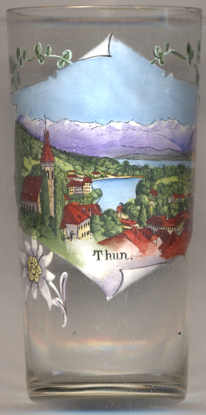

|
| SCHWEIZ / SUISSE / SVIZZERA / SVIZRA | SWITZERLAND |
| Bern / Berne / Berna / Berna |
de: Thun
| fr: Thoune
| |
Thun is situated at an elevation of 560 m on the river Aare, just downstream of the point where that river flows out of Lake Thun, and encompasses both banks of the river and an island between. The municipality has a population of about 43,600 (2016) and thus is the eleventh largest city in Switzerland; the agglomeration has a population of about 90,000. Thus is the administrative centre of the district of the same name within the canton Bern.
 The area of what is now Thun was inhabited since the Neolithic age (mid-3rd millennium BC). During the early Bronze Age
there were a number of settlements along the lake shore and the Aare. The name of the town derives from the Celtic term
Dunum, meaning "fortified town". It fell to Rome in 58 BC, when Roman legions conquered almost all of
Switzerland, and it soon became one of the main centers of Roman administration in the region. The Romans were driven out
of Thun, and out of the rest of Switzerland, by the Burgundians around 400 AD. The Aare became the frontier between
the Christian Burgundians and the Pagan, German-speaking Alemanni, who lived north. The town is first mentioned in 1133
as Tuno. The region of Thun became a part of the Holy Roman Empire in 1033, when Konrad II gained the title
of King of Burgundy. The emperors entrusted the Zähringen family, centred in Bern, with
subduing the unruly nobles of central Switzerland. Around 1190 Duke Berthold V of Zähringen, built Thun castle
and expanded the town. After Berthold's death in 1218, his territories went to Ulrich III von Kyburg. In 1264 Thun
received town rights and in 1384 the town was bought by the canton of Bern. Thun was the capital of the Canton of Oberland
of the Helvetic Republic, which lasted from 1798 until 1803. In 1819 a Military School was founded in the town, which later
developed into the main military school in Switzerland. Today, Thun is still the largest garrison town of the Swiss Army.
The area of what is now Thun was inhabited since the Neolithic age (mid-3rd millennium BC). During the early Bronze Age
there were a number of settlements along the lake shore and the Aare. The name of the town derives from the Celtic term
Dunum, meaning "fortified town". It fell to Rome in 58 BC, when Roman legions conquered almost all of
Switzerland, and it soon became one of the main centers of Roman administration in the region. The Romans were driven out
of Thun, and out of the rest of Switzerland, by the Burgundians around 400 AD. The Aare became the frontier between
the Christian Burgundians and the Pagan, German-speaking Alemanni, who lived north. The town is first mentioned in 1133
as Tuno. The region of Thun became a part of the Holy Roman Empire in 1033, when Konrad II gained the title
of King of Burgundy. The emperors entrusted the Zähringen family, centred in Bern, with
subduing the unruly nobles of central Switzerland. Around 1190 Duke Berthold V of Zähringen, built Thun castle
and expanded the town. After Berthold's death in 1218, his territories went to Ulrich III von Kyburg. In 1264 Thun
received town rights and in 1384 the town was bought by the canton of Bern. Thun was the capital of the Canton of Oberland
of the Helvetic Republic, which lasted from 1798 until 1803. In 1819 a Military School was founded in the town, which later
developed into the main military school in Switzerland. Today, Thun is still the largest garrison town of the Swiss Army.
The  Town Church Thun [left] is the Reformed main church of the town.
While the church tower dates from around 1330 and was ornated with frescos around 1430, the church itself was rebuilt
in 1738 in late Baroque style, replacing a previous, Gothic church dedicated to St.&8237;Maurice which had originated im
the 13th century. The communion table is a Renaissance work dating from 1602, the pulpit was created in 1661.
Town Church Thun [left] is the Reformed main church of the town.
While the church tower dates from around 1330 and was ornated with frescos around 1430, the church itself was rebuilt
in 1738 in late Baroque style, replacing a previous, Gothic church dedicated to St.&8237;Maurice which had originated im
the 13th century. The communion table is a Renaissance work dating from 1602, the pulpit was created in 1661.
[https://de.wikipedia.org/wiki/Thun, http://en.wikipedia.org/wiki/Thun;
https://de.wikipedia.org/wiki/Stadtkirche_Thun]
![[scale]](lineal.jpg)